The Waning Late-night Moon Lets Us Walk the Dog’s Stars and Watch for Dust While February Leaps into March!

This spectacular image by my friend Andrea Girones was taken recently at Morant’s Curve, Alberta using a DSLR with a 20mm lens on a star tracking mount. It captures the arc of faintly glowing reddish hydrogen gas around Orion and the nimbus around his head (at left), the bright compact Rosette Nebula (upper left), Mars (top centre), the Pleiades cluster (right of centre), and brilliant Venus embedded within the tilted band of the zodiacal light (lower right). Her original FaceBook post is here.
Hello, March Stargazers!
Here are your Astronomy Skylights for the week of February 25th, 2024 by Chris Vaughan. Feel free to pass this along to your friends and send me your comments, questions, and suggested topics. You can also follow me on Twitter as @astrogeoguy! Unless otherwise noted, all times are expressed in Eastern Time. To subscribe to these emails please click this MailChimp link.
If you’d like me to bring my Digital Starlab portable inflatable planetarium to your school or other daytime or evening event, or deliver a session online, contact me through AstroGeo.ca, and we’ll tour the Universe, or the Earth’s interior, together! My book with John A. Read entitled 110 Things to See With a Telescope is a guide to viewing the deep sky objects in the Messier List – for both beginners and seasoned astronomers. DM me to order a signed copy!
The bright, recent mini-moon will slip into the post-midnight sky this week, allowing us to appreciate the sights in Canis Major, some spring galaxies, and the zodiacal light. Jupiter will reign in the west after sunset (for a while longer) while Queen Venus bids Mars (and us) adieu before sunrise. Read on for your Skylights!
Leaping into March
Thursday, February 29th will be a Leap Day! We add an extra day to the end of February every four years in order to keep our calendar from drifting. Here’s why. A year is defined as the time taken for a planet to orbit precisely once around the sun. In Earth’s case, that is 365.2425 days (call it 365¼-ish days). Each of our four seasons commences when Earth reaches one of four particular spots in its orbit, roughly every three months.
That extra quarter of a day, if not taken care of, would eventually cause dates to occur when the Earth has travelled much farther along its orbit. In four years, it’s roughly a day’s worth. After a few hundred years, summer weather would be arriving when the calendar on the wall says it’s March. The dates for Easter, Passover, and the Chinese and Persian New Year festivals would move around the calendar, too. For example, Easter always occurs on the Sunday following the first Full Moon after the Vernal Equinox (i.e., the first day of spring in the Northern Hemisphere).
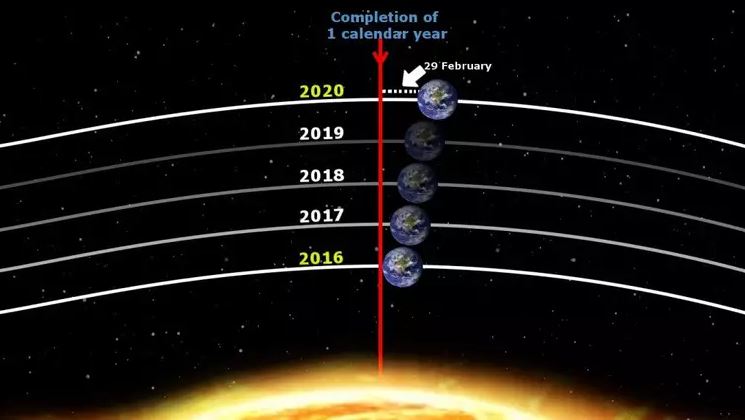
People knew about the issue since antiquity – so scholars for Julius Caesar (100-44 BCE) created a calendar that added a leap day every four years, inserting the first Leap Day in the year 8 AD. But by 1582, the calendar had still drifted by 10 days! Why? Because our year is actually about 11 minutes and 14 seconds longer than exactly 365¼ days. To solve this, Pope Gregory XIII implemented the Gregorian Calendar, fixing the error by deleting the ten days from October 4 through 15, 1582, and also refining the system of leap days. Henceforth, to keep everything correct, we don’t add a Leap Day in years that are divisible by 100, unless the year is divisible by 400. Under that model, the year 2000 was a leap year and 2100 will not be. All of these gyrations will keep us nearly precisely on track.
If future residents of Mars adopt a Martian calendar, it will have more frequent leap days than we do. The Mars year is 668.5991 Martian days (or sols) in length, requiring the addition of three leap days every five years. Maybe they’ll use them as a bonus long weekend to celebrating the first human on the Red Planet!
Evening Zodiacal Light
If you live in a location where the sky is free of light pollution, you might be able to spot a phenomenon called the zodiacal light during the two weeks that precede the new moon arriving on March 10. Starting on Monday, February 26, after the evening twilight has faded, you’ll have about half an hour to check the western sky for a broad wedge of faint light extending upwards from the horizon and centered on the ecliptic below the planet Jupiter. That glow is the zodiacal light – sunlight scattered from countless small particles of material that populate the plane of our solar system. Don’t confuse it with the brighter Milky Way, which extends upwards from the northwestern evening horizon at this time of year.
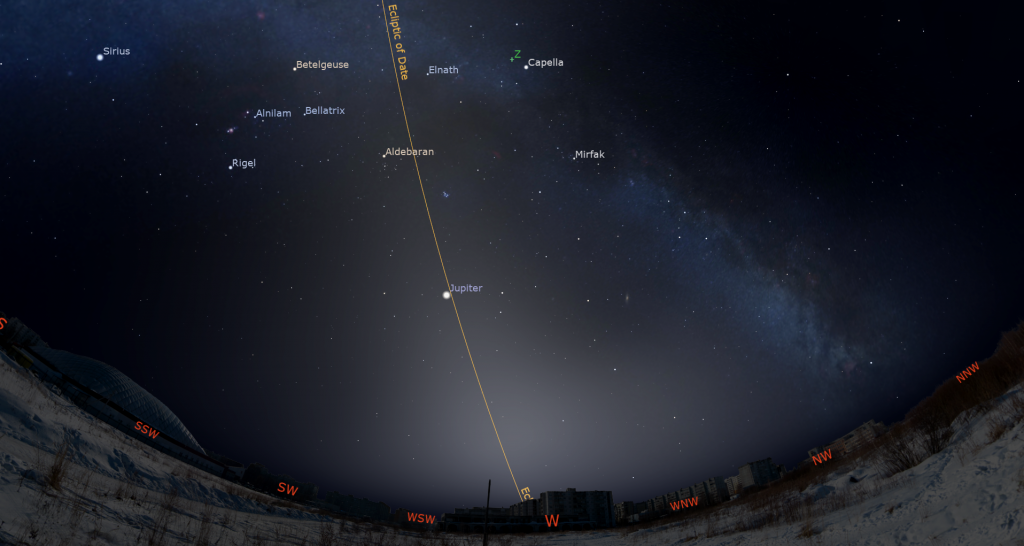
The Moon
After Saturday morning’s mini full moon, our natural satellite will spend the coming week waning in phase and rising later. That will lead to darker evening skies worldwide as we approach the weekend.
Tonight (Sunday) the 98%-illuminated moon will clear the rooftops in the east around 8 pm local time. You should be able to notice that it is “flatter” on the upper right – where the terminator is just starting to drag a veil of darkness across the moon’s disk. Your binoculars or backyard telescope will reveal a thin strip of textured craters along that limb. The rest of the moon will look rather uninteresting in comparison. You might want to wear sunglasses to reduce the moon’s glare through your optics!
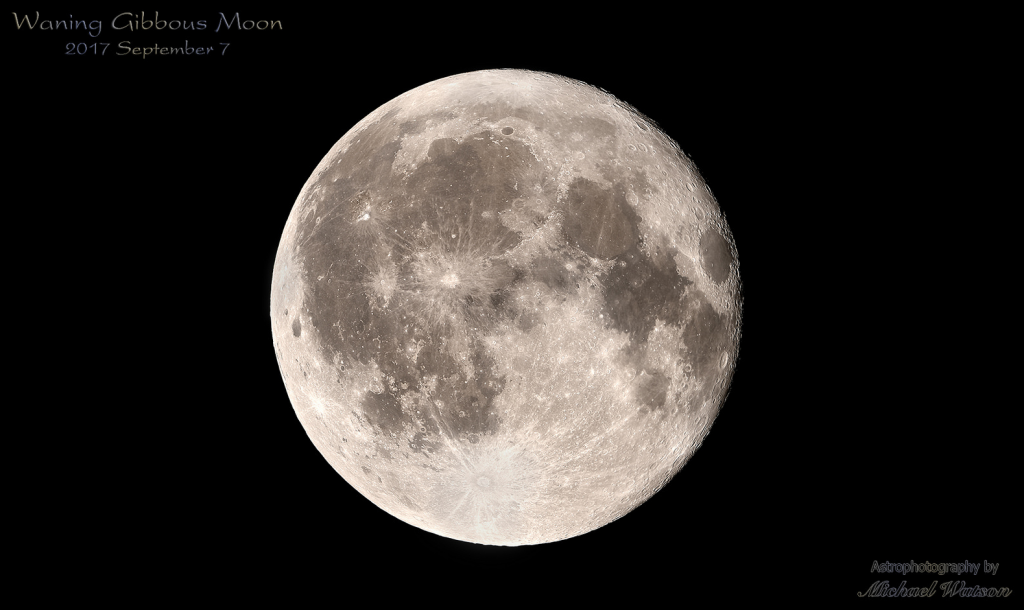
Before turning away, see if you can detect the extra dark and bluish tint of Mare Tranquillitatis. Its dark basalts are enriched in titanium, one of the reasons for its selection as the destination of Apollo 11 in 1969. If you direct your focus on the centre of the moon above and between the prominent craters Tycho and Copernicus, you can see the trio of dark stains of volcanic ash within the crater Alphonsus. I mentioned them in my note about how the moon may have come to grace our skies last week here. Pay some attention to the prominent ray systems emanating from Tycho and Copernicus, and other young craters. The rays have both different styles and are not radially symmetrical, telling us about the direction and approach angle that the object that created those craters had. There are lots of ray systems, if you look for them.
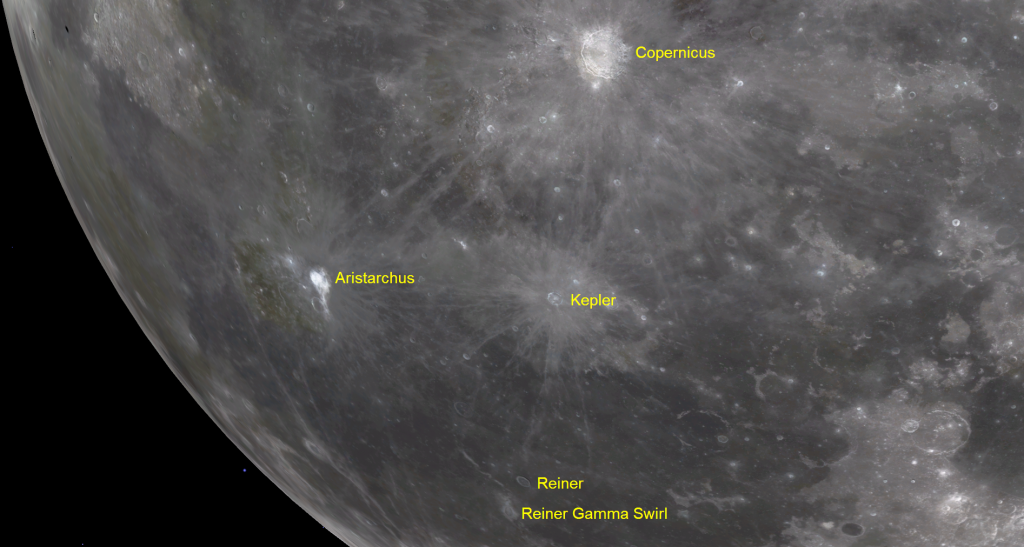
If you aim a telescope at a point about twice the span from Copernicus to Kepler, you can see one of the moon’s enigmas. The Reiner Gamma Lunar Swirl is a small, high-albedo (i.e., light in colour) area located just inside the western edge of Oceanus Procellarum. It is best seen a night or two after the moon’s full phase every month. The easily-seen, 30 km-diameter crater of Reiner is located a short hop to the upper right (or lunar east-southeast) of Reiner Gamma. The swirl is composed of ancient lunar basalt that has not been darkened by weathering, likely due to protection from cosmic rays by a strong localized magnetic field – the swirl has one of the strongest magnetic anomalies on the moon! At high magnification, its complex, fish-like shape is fascinating. Take a look over the next several nights!
Sunday night’s moon will overwhelm the modest stars of Virgo, the Maiden, which are spread out to its celestial east. During the night, the diurnal rotation of the sky will lift the constellation from the moon’s lower left to its upper right. The moon will need until Thursday to cross the lengthy form of Virgo. On Tuesday night, the moon will shine above Virgo’s brightest star Spica.
At mid-northern latitudes, the waning gibbous moon will rise an hour later each night and then linger longer in the southwestern sky after sunrise.
The moon will leap into Libra (the Scales) overnight on Thursday, February 29. Starting that night, you will have several good hours of dark skies after dusk to enjoy the sights in the late winter sky and perhaps start to dip into the spring galaxies contained in Leo (the Lion), Coma Berenices (Berenice’s Hair), and Canes Venatici (the Hunting Dogs). I’ll highlight those in more detail next week.
Night owls on Saturday morning can see the moon approaching the claw stars of Scorpius (the Scorpion). When the half-illuminated, third quarter moon appears over the rooftops in the southeastern sky around 2 am local time on Sunday morning, March 3, it will be positioned very close to Scorpius’ brightest star, Antares. Skywatchers located in the southeastern USA, Central America, the Caribbean, and northeastern South America can use unaided eyes, binoculars, and backyard telescopes to watch the moon cross in front of (or occult) Antares between about 1:55 and 3:05 am EST. Use an astronomy app like Star Walk 2 or Stellarium or Sky Safari to determine your local times for the event. The surrounding regions will see the northern pole of the moon pass very close to the star. The duo will be visible until almost dawn, though the moon will have moved farther from the star by then.

The moon will formally reach its third quarter phase on next Sunday, March 3 at 10:23 am EST or 7:23 am PST, which converts to 15:23 Greenwich Mean Time.
The Planets
The countdown to Jupiter’s departure continues this week. The combination of Earth’s orbital motion around the sun and Jupiter’s own trek eastward along the ecliptic make the planet set three minutes earlier every day. Since Uranus is located a short distance to Jupiter’s east, both planets will get lower in the western sky every night and will become completely hidden in the post-sunset twilight by the end of April. Other than occasional visits by Mercury, and brief pre-dawn views of Mars and Saturn, the night sky worldwide will be without planets until Saturn returns in July. Bear that in mind if you are thinking of buying a telescope to see planets in the short term.
This week, Jupiter’s brilliant dot will emerge high in the southwestern sky as the sky begins to darken after sunset. Plan to make your telescope viewing of Jupiter as soon as you can see the planet. Bright planets can show more detail in a twilight sky. Under steady air conditions, you’ll get good views of Jupiter in any telescope until about 9:30 pm local time. Then the planet will set around 11:30 pm local time. Jupiter is shining between the stars of Aries (the Ram) on its upper right (or celestial north) and the palm’s-wide ring of stars forming the head of Cetus (the Whale) on its lower left.
Any decent pair of binoculars can show you Jupiter’s four largest Galilean moons lined up on both sides of the planet. Named Io, Europa, Ganymede, and Callisto in order of their orbital distance from Jupiter, those moons complete orbits of the planet every 1.7, 3.6, 7.2, and 16.7 days, respectively. If you see fewer than four moons, then one or more of them is crossing in front of or behind Jupiter, or hiding in Jupiter’s dark shadow – or two of the moons are very close together or occulting one another. All four moons will gather to Jupiter’s western (lower) side on Monday evening.
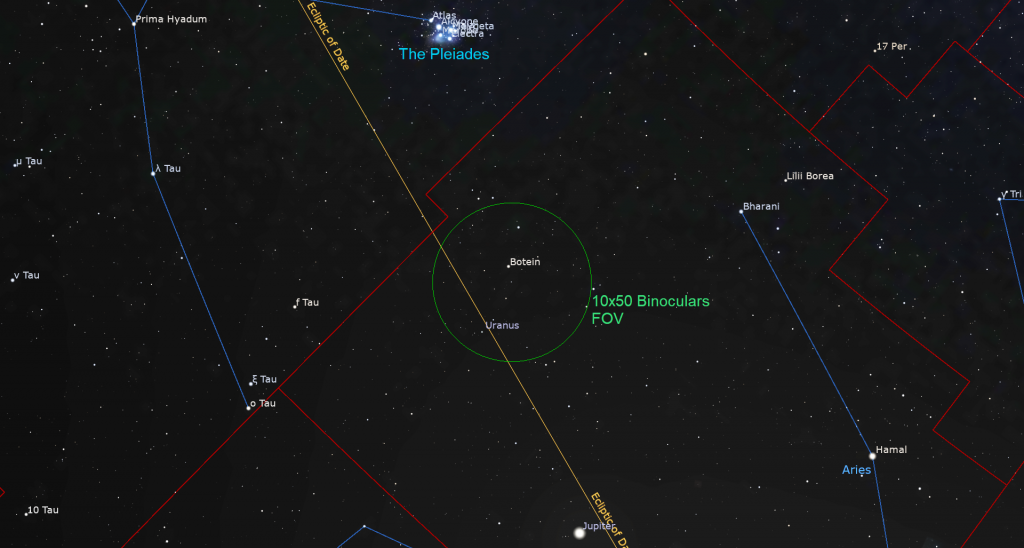
A small telescope will reveal Jupiter’s dark belts and light zones, which are aligned parallel to its equator. When Jupiter is descending in the west, those lines are tilted upright. With a better grade of optics, Jupiter’s Great Red Spot, a cyclonic storm that has raged for hundreds of years, is visible for several hours when it crosses the planet every 2nd or 3rd night. For observers in the Americas, the GRS will cross Jupiter’s disk in mid-evening Eastern Time on Monday and Saturday. The spot will appear late on Wednesday and Friday. The spot has been rather a pale pink in colour for some time now. If you have any coloured filters or nebula filters for your telescope, try enhancing the spot with them.
From time to time, the small, round, black shadows cast by Jupiter’s Galilean moons become visible in amateur telescopes when they cross (or transit) the planet’s disk. For those in the Americas, Io’s small shadow will cross Jupiter on Thursday, February 29 from 6:48 to 8:54 pm EST (or 23:48 to 01:54 GMT). (These times may vary by a few minutes, and other time zones of the world will have their own crossings.)
Blue-green Uranus is located 50 minutes behind Jupiter on the ecliptic, in the southeastern region of Aries (the Ram). The magnitude 5.8 planet is quite easy to see in binoculars and backyard telescopes, especially once this week’s moon starts to rise later. Look for Uranus less than a fist’s diameter to Jupiter’s upper left (or 8.5° to its celestial east). Uranus will be positioned about two finger widths below the medium-bright star Botein, and the bright Pleiades star cluster will be located a generous fist’s width above Uranus (or 11.5° to its celestial northeast). Since it’s closer to the sun than Uranus, Jupiter’s faster motion will move it steadily closer to Uranus every night until they kiss in twilight on April 20.
Mercury, Saturn, and Neptune are all out of sight at conjunction near the sun this week.
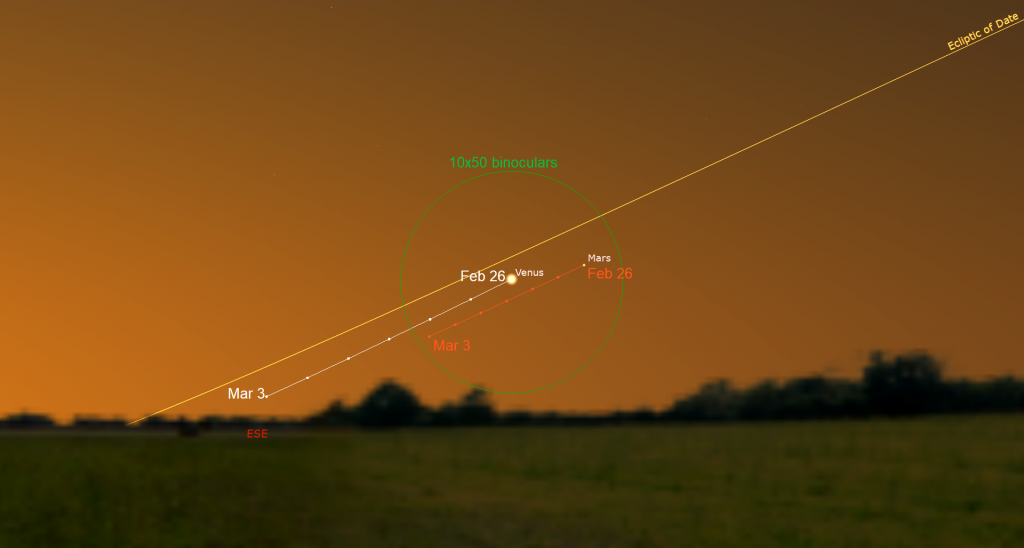
I was lucky enough to see Venus the morning after it kissed Mars last Thursday. Both planets were dancing in the turbulent air just above the east-southeastern horizon before sunrise. Venus, which was tinted yellow by the thick blanket of air between her and my binoculars, showed a slightly flattened top owing to its 90%-full disk. Mars gave off the occasional flash of red as it twinkled furiously.
To see Venus yourself, head out on a clear morning and look very low in the ESE sky before sunrise. No binoculars will be needed to see its magnitude -3.9 speck – but you may have to walk around to avoid trees or buildings. Venus is swinging left and sunward every morning, but her very sloped orbital plane will have her rising at about the same 6 am time every morning.
Far fainter Mars might not be visible with your unaided eyes, but binoculars will capture it easily. Mars will slip farther to Venus’ upper right each morning. Skywatchers closer to the tropics will see Mars and Venus more easily.

Next Sunday night, the major main belt asteroid named (3) Juno will reach opposition. At that time, Earth will be passing between the asteroid and the sun, minimizing our distance from Juno and causing it to appear at its brightest and largest for this year. The magnitude 8.7 object will be visible in backyard telescopes all night long. On opposition night, Juno will be positioned in a rather featureless part of the sky below (south of) the brightest stars of Leo – specifically, a slim fist’s diameter below the midpoint of the line connecting Regulus to Denebola. Those bright stars mark the lion’s chest and tail, respectively.
Walking the Dog’s Stars
The night sky’s brightest star Sirius is sure to catch your eye in the evening sky this time of the year. Once the sky darkens after about 7 pm local time, Sirius will be sitting less than a third of the way up the southern sky, to the lower left of Orion (the Hunter) and his famous belt. Sirius will reach its highest position over the southern horizon at 8:30 pm and then descend into the southwestern sky and set by 1:30 am local time.
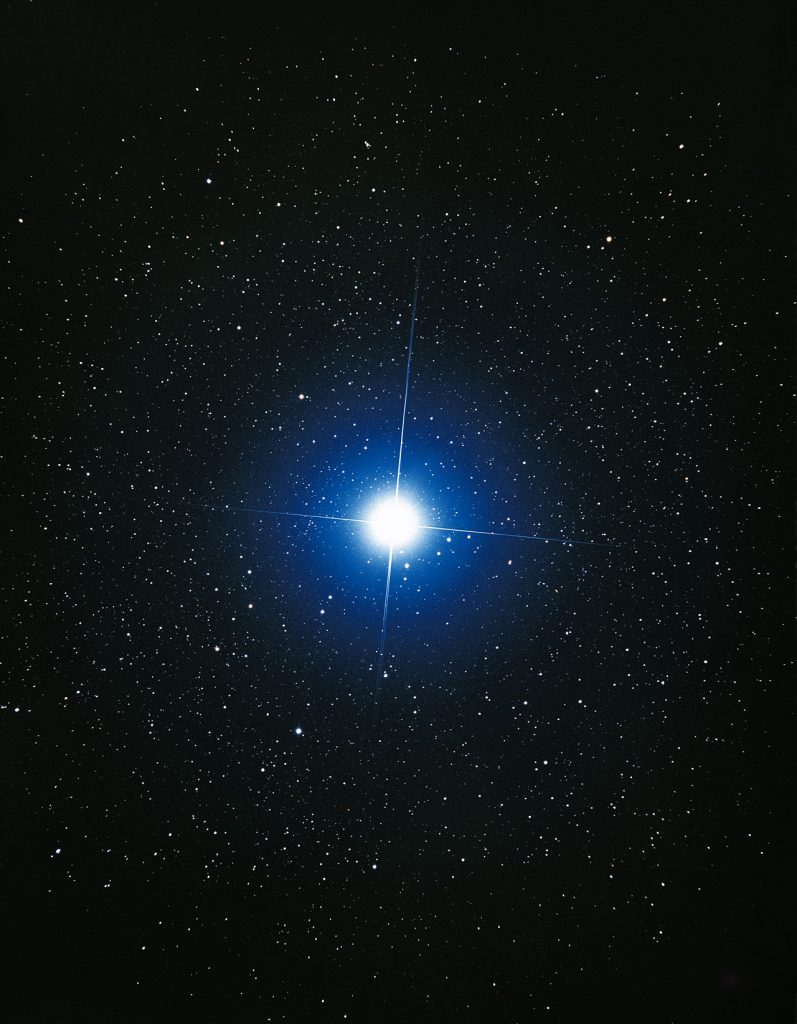
Sirius’ name means “searing” or “scorching” in Greek. It’s also commonly known as the Dog Star and Alpha Canis Majoris (α CMa) because it is the brightest star in the constellation of Canis Major (the Big Dog). To my eyes, the constellation genuinely resembles a wiener dog, with Sirius sparkling as the dog’s collar tag! The pup’s head is formed by a triangle of medium-bright stars to Sirius’ upper left (celestial east), but those are near the limit of visibility in urban skies. Nose to tail, the constellation covers about 19°, or two fist diameters. From ears to paws, he spans about one fist diameter. The rest of the dog’s body, composed of more easily visible stars, extends to the lower left (southeast) of Sirius. Rover is rearing up and facing west, as if he is begging Orion for a treat.
Canis Major’s location only about 20° south of the celestial equator allows it to be visible at times from everywhere on Earth except far northern latitudes. That has made the distinctive star pattern a feature of many cultures’ sky. In addition to Orion, the Big Dog is chasing Lepus (the Hare), which shines to his right (celestial west). Above (north of) him are the faint stars of Monoceros (the Unicorn). Observers at latitudes south of Canada can also see the constellations Puppis (the P**p Deck) and Columba (the Dove) underneath him.
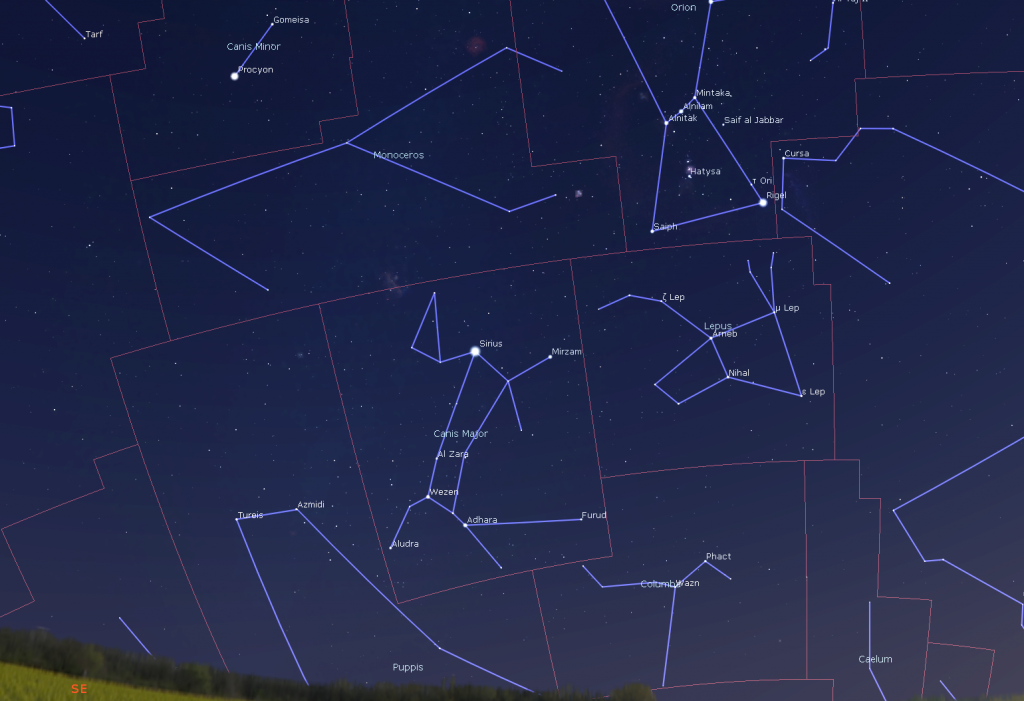
About a fist’s diameter below Sirius shines the bright star Wezen (δ CMa), which marks the dog’s, um, “bottom”. Wezen, from the Arabic phrase Al Wazn “weight” is a rare, massive, yellow supergiant star. One day it will explode in a supernova. The tip of the dog’s tail, marked by a modest star named Aludra (η CMa), is found 4° (four finger widths) to the lower left of Wezen. Two finger widths above Wezen you’ll find two less conspicuous stars positioned side-by-side and separated by two finger widths. They nicely demark the dog’s slim torso. The left-hand (celestial east) star is whitish Al Zara. To the right is fainter and orange-tinted star Udra. Both stars are designated Omicron Canis Majoris (o CMa). Al Zara is Omicron2 CMa. This modest point of light, 2760 light-years away from Earth, is a massive supergiant star – one of the most luminous stars known. It radiates about 220,000 times as much visible light as the sun. Since 1943, the spectrum of Al Zara has served as one of the reference points from which other stars are classified. Udra or Omicron1 CMa is also a supergiant that has inflated and cooled. It’s about 3500 light-years away.
If you aim binoculars or your telescope slightly more than double the distance from Udra to Al Zara, you’ll land on the double star designated 145 CMa and HR2764, but better known as the Winter Albireo. It will appear as a gorgeous, coloured pair of stars – one orange and one blue – snuggled close together.

Four degrees to the lower right of Wezen, a bright star named Adhara (ε CMa) represents the dog’s rear legs. (Some representations include two dimmer stars for the rear paws.) Adhara is a hot blue giant star with a surface temperature of a whopping 21,000 K and located about 34 light-years from the sun. It’s the brightest star in the sky when viewed in ultraviolet light, and it, too, is on the way to death by supernova. Arabic astronomers associated the stars Adhara, Aludra, Wezen, and Al Zara with the Maidens in one of their stories.
The dog’s front legs are formed by the bright star Mirzam (β CMa), which is located about a palm’s width to the lower right of Sirius. Mirzam, which means “the Herald” because it rises just before Sirius, is 60 times more luminous than Sirius. If that star were located where Sirius is, instead of 500 light-years away from us, it would appear 15 times brighter than Venus!
A triangle of stars form the dog’s head to the upper left of Sirius. They include the bright, blue-white giant star Muliphein (γ CMa) marking his eye, the orange giant star Theta CMa above it that marks his nose, and the slightly fainter star Iota CMa closest to Sirius. Iota is a blue-white supergiant star 46,000 times more luminous than the sun and located 300 times farther away than Sirius!
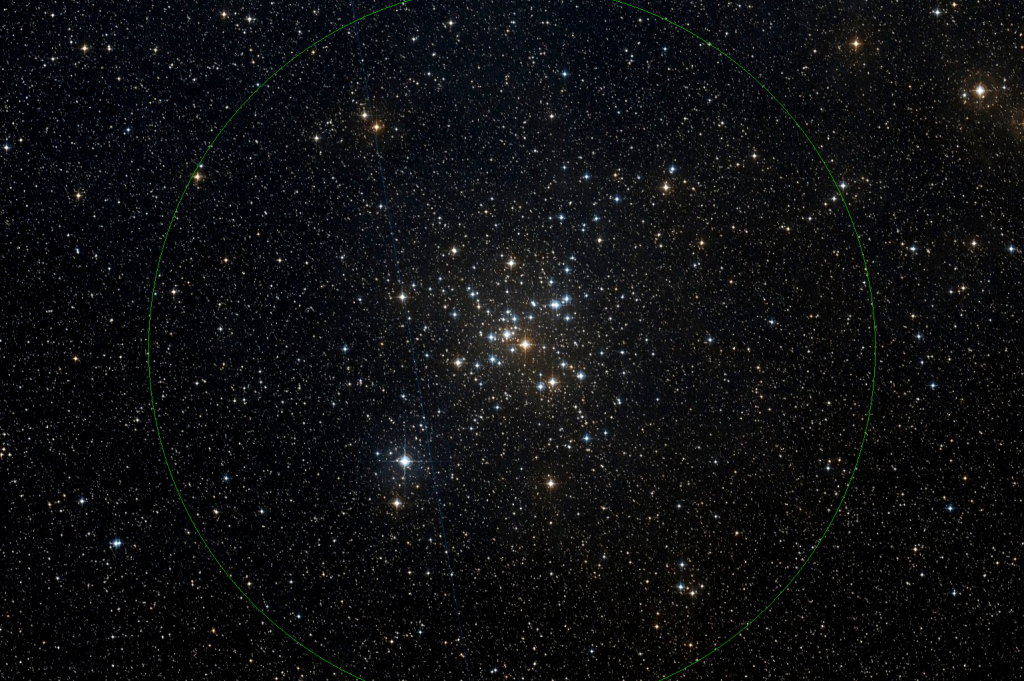
In the heart of Canis Major, about four finger widths below Sirius, is a bright little cluster of stars designated Messier 41, sometimes called the Little Beehive Cluster. Binoculars can show it easily. The cluster, which is about 2,300 light-years away from our sun, consists of several brighter golden stars and numerous fainter ones. Another nice cluster named NGC 2354 sits about 2.5 finger widths to the upper left of Wezen. An even nicer, but smaller, cluster sits three finger widths to the left (celestial east) of Wezen. It’s formally known as the Tau CMa Cluster and NGC 2362, and also the Mexican Jumping Star and Pirate’s Jewels Cluster. In a telescope, it reminded me of a glittering Eiffel Tower!

A bright little nebula with an unusual shape is located almost a fist’s diameter to the upper left (or 8.8 degrees to the celestial northeast of Sirius. NGC 2359 is aglow with a mixture of reddish light from ionized hydrogen and some blue light scattered by interstellar dust. “Wings” of gas flanking the main zone have given it the nick-names Thor’s Helmet, the Duck Nebula, and the Flying eye Nebula. Scan around that area of sky with your binoculars – the winter Milky Way has populated Canis Major with many such dog treats.
Sirius is so bright because it is about 25 times more luminous than our Sun, and is only a mere 8.6 light-years away from Earth. Furthermore, it is heading towards us, and will brighten over the next millennia! Sirius has a tiny companion – a white dwarf star designated Sirius B, that some astronomers call the Pup. I prefer to call it the Flea!

Sirius is famous for exhibiting flashes of intense colour as it twinkles. This is because northern hemisphere observers usually see the star positioned low in the sky, so that its very bright light is passing through a thicker blanket of air. The pockets of turbulence in our atmosphere that makes stars twinkle also work like tiny refracting prisms – splitting apart Sirius’ white light and randomly sending different colours (wavelengths) to our eyes.
The ancient Egyptians linked their calendar to the arrival of Sirius in the pre-dawn sky because it signaled the onset of the Nile floods around the beginning of summer. That phenomenon also gave us the expression “Dog Days of Summer”. In China, Sirius is called Tiān Láng天狼, aka “the Celestial Wolf”. Many First Nations cultures saw a dog’s shape in these stars and called Sirius the Moon Dog Star (Inuit), the Wolf Star (Pawnee), and the Coyote Star. On the next clear evening, have a look at our bright neighbour!
Public Astronomy-Themed Events
Every Monday evening, York University’s Allan I. Carswell Observatory runs an online star party – broadcasting views from four telescopes/cameras, answering viewer questions, and taking requests! Details are here. They host in-person viewing on the first clear Wednesday night each month. Other Wednesdays they stream views online via the observatory YouTube channel. Details are here.
On Saturday, March 2 from 10 am to noon, you can try out Solar Observing at the Ontario Science Centre! If it’s sunny, members of the RASC Toronto Centre will be setting up outside on the Teluscape in front of the main doors. They’ll have an array of special equipment designed to view the Sun safely. This is free to the public, but parking and admission fees inside the Science Centre will still apply. Check the RASC Toronto Centre website or their Facebook page for the Go or No-Go notification.
Keep your eyes on the skies! I love getting questions and requests. Send me some!